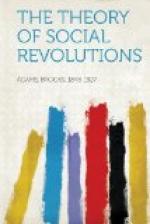“He treated with the utmost contempt the idea of an independent judiciary.... And if the judges of the Supreme Court should dare, as they had done, to declare an act of Congress unconstitutional, or to send a mandamus to the Secretary of State, as they had done, it was the undoubted right of the: House of Representatives to impeach them, and of the Senate to remove them, for giving such opinions, however honest or sincere they may have been in entertaining them. * * * And a removal by impeachment was nothing more than a declaration by Congress to this effect: You hold dangerous opinions, and if you are suffered to carry them into effect you will work the destruction of the nation. We want your offices, for the purpose of giving them to men who will fill them better."[13]
Jefferson, though he controlled a majority in the Senate, failed by a narrow margin to obtain the two-thirds vote necessary to convict Chase. Nevertheless, he accomplished his object. Chase never recovered his old assurance, and Marshall never again committed a solecism in judicial manners. On his side, after the impeachment, Jefferson showed moderation. He might, if he had been malevolent, without doubt, have obtained an act of Congress increasing the membership of the Supreme Court enough to have put Marshall in a minority. Then by appointing men like Giles he could have compelled Marshall to resign. He did nothing of the kind. He spared the Supreme Court, which he might have overthrown, and contented himself with waiting until time should give him the opportunity to correct the political tendencies of a body of men whom he sincerely regarded as a menace to, what he considered, popular institutions. Thus the ebullition caused by Marshall’s acrimony toward Jefferson, because of Jefferson’s strictures on the appointments made by his predecessor subsided, leaving no very serious immediate mischief behind, save the precedent of the nullification of an act of Congress by the Supreme Court. That precedent, however, was followed by Marshall’s Democratic




